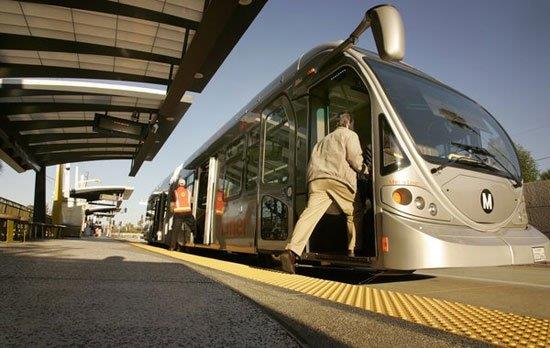Locking in fares on the Orange Line
May 8, 2014
Fare gates—they may not be just for trains anymore.
When Metro began latching the turnstiles to L.A.’s subways last year, it marked the beginning of the end for the decades-old honor system that enabled many to ride for free. Since then, gate latching has spread rapidly. By the end of May, all rail stations with turnstiles will require a valid TAP card for entry.
Now similar barriers may be coming to the Orange Line busway, which provides rail-like service in bus-only lanes.
A Metro report released Monday said it would be possible to gate all 18 stations of the San Fernando Valley line. Metro’s Board of Directors later this month will decide whether to install gates at an estimated cost of $24.6 million, or go with another option, such as rearranging non-latched card readers—known as “stand-alone validators”—to encourage more people to use their TAP payment cards.
The report recommends a more detailed engineering analysis on installing gates while also testing the stand-alone validator plan at two stations. The non-gating option is cheaper initially and quicker to implement, but it would still rely on the honor system and enforcement by the Sheriff’s Department, said David Sutton, who heads up the gate latching project for Metro.
“Gating is more compulsory,” Sutton said. “It’s going to stop you if you don’t tap. A stand-alone validator is not going to stop you.”
The effectiveness of simply rearranging the TAP card validators is unknown. The option is currently being tested at light rail stations but “the jury is still out,” Sutton said.
If the agency decides to go the gating route, most Orange Line stations will pose no major logistical barriers. However, because the Warner Center station is situated on a public sidewalk, the agency would need to purchase land from the City of L.A. to create space for gates. And, at the heavily-used North Hollywood Station, twice as many gates will be needed to ensure that passengers can get in and out quickly and safely. The entire process, from planning to construction, could take two years or more, Sutton said.
For gating on the Orange Line to be effective, additional fencing must be installed. The current fencing along the backs of station platforms is only 3½ -feet high. It would need to be modified or replaced with 5-foot-high fencing to keep out all but the most dedicated scofflaws.
The move toward gating the Orange Line started in January, after Sheriff’s reports showed that up to 22% of riders were not paying their way. Metro’s Board of Directors, acting on a motion by Supervisor Zev Yaroslavsky and L.A. City Councilmember Paul Krekorian, directed the agency to develop options to fix the problem.
As plans move forward, Sheriff’s Commander Michael Claus—Metro’s head of security—has already ramped up enforcement. By February 11, the fare evasion rate had come down to 7%. And, to bolster his team’s efforts, Claus released a 30-second video that is being broadcast on the buses via on-board televisions. The clip shows riders how to load and use their payment cards—and what the consequences will be if they don’t. Citations for single offenses are usually $75, the current cost of an unlimited 30-day pass.
The estimated $24.6 million cost of gating the Orange Line could be offset by increased revenues. Last fall, Metro estimated it would recover an additional $6 million per year in fares from latching the Red Line alone. Still, according to agency spokesperson Paul Gonzales, installing gates may prove too costly at some locations.
“Some stations may take 10 or 15 years to pay off,” Gonzales said. “Is that worth it? That’s something the Board will have to decide.”
The Orange Line decision comes as the agency faces the possibility of fares going up—always a contentious proposition. Still, even if fares increase, the riding public may be able to take some solace in the fact that there will be fewer freeloaders on the system.
“There’s a basic element of fairness,” Gonzales said. “People think, ‘Why should I pay and other people not pay?’ ”
The decision on the Orange Line goes to the System Safety and Operations committee meeting next week before heading to the full Board for consideration on May 22.
Posted 5/9/14













 405 bridge work causes a stink
405 bridge work causes a stink

